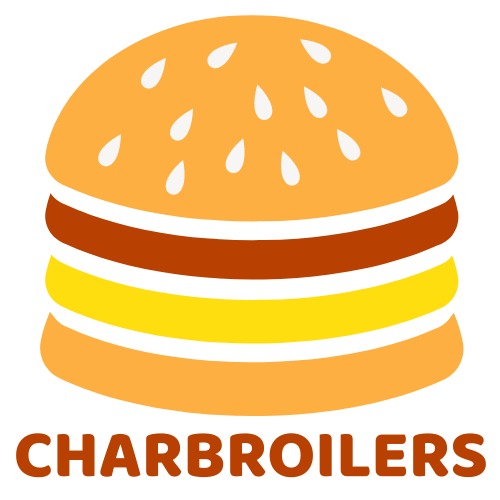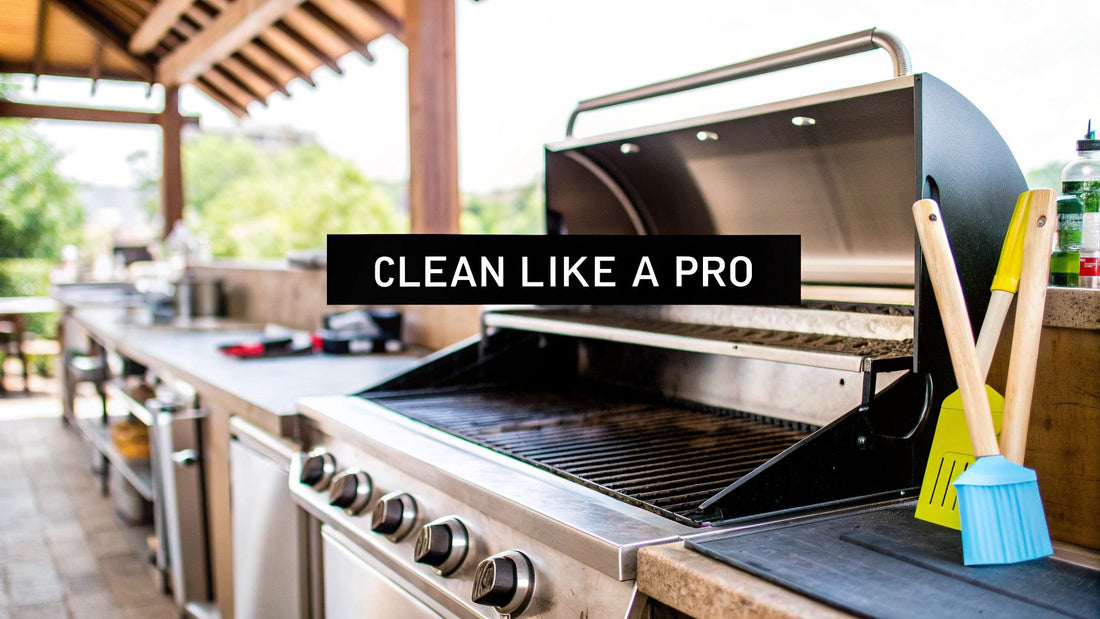
How to Clean Your Grill Like a Pro
Share
Knowing how to clean your grill is pretty straightforward: pull the grates, scrub off all the gunk, and hit the inside with a good degreaser. Sticking to a daily routine is the single best way to prevent dangerous grease buildup, get rid of those bitter flavors from old carbon, and make sure your equipment runs safely and efficiently for years.
Why Grill Maintenance Is Non-Negotiable
A spotless grill is the heart and soul of any kitchen that takes pride in its food. But keeping it that way is about much more than just looking good. A dirty charbroiler directly tanks your food quality, creating a major problem for both flavor and safety.
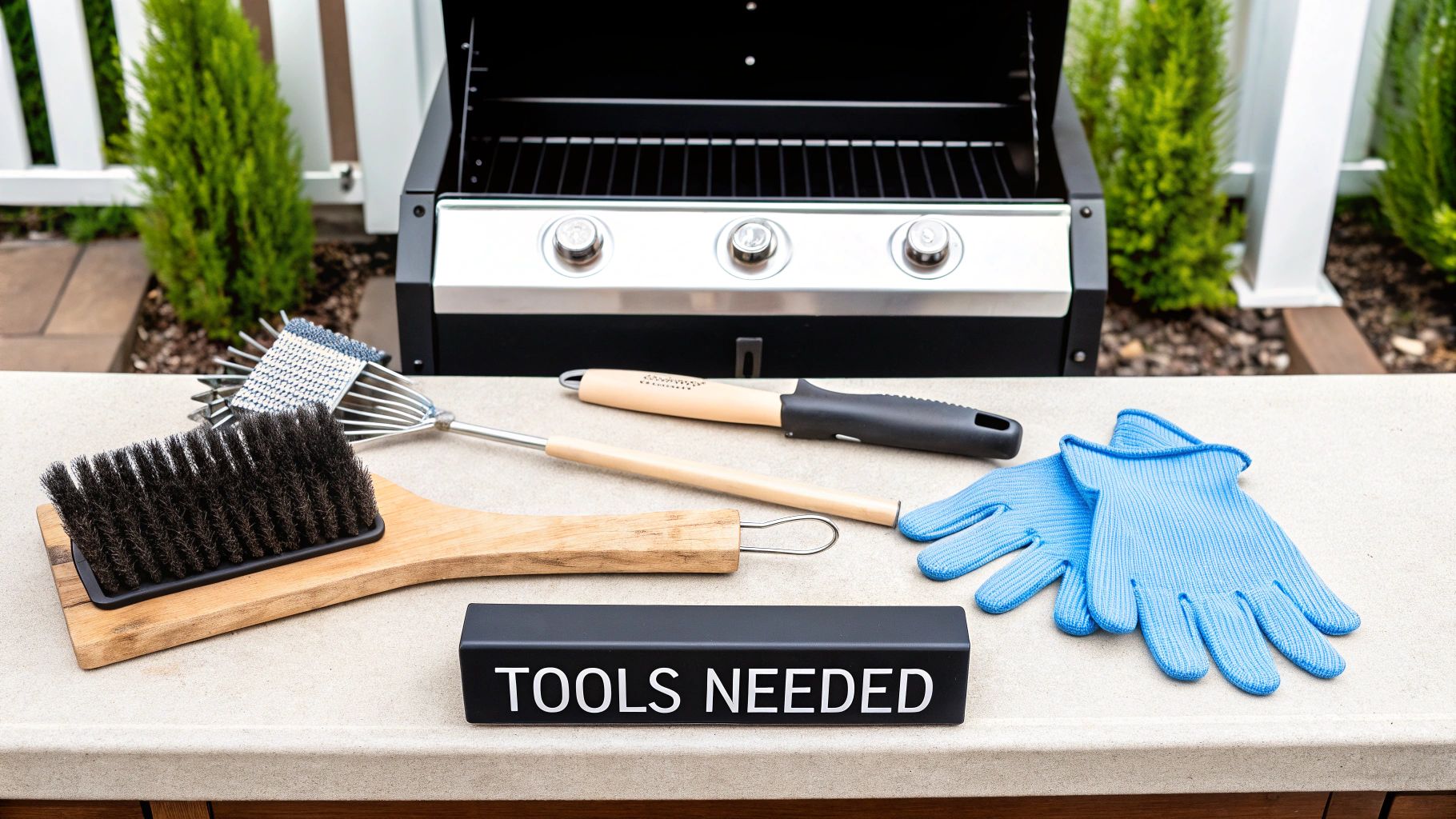
When you let carbonized food bits and old grease build up on the grates, you're setting yourself up for failure. That buildup doesn't just cause hot spots and uneven cooking; it imparts a nasty, burnt taste to fresh ingredients, completely overpowering the natural flavors you're working so hard to perfect.
The Real Costs of a Dirty Grill
Beyond the taste, you’re looking at some serious operational and safety risks. That caked-on grease is the number one fuel source for kitchen fires—a disaster that's easily avoided with a consistent cleaning schedule. On top of that, a well-maintained grill just works better.
- Better Heat Distribution: Clean burners and grates mean heat spreads out evenly. No more hot spots torching one side of a steak while the other side is still rare.
- Longer Equipment Life: Regular cleaning stops corrosive grease from eating away at vital components, which means your expensive equipment will actually last.
- Real Energy Savings: An efficient grill gets to temperature faster and stays there using less energy. Over time, that translates into noticeable savings on your utility bills.
This isn’t just something we preach in the industry; the market reflects it. The global demand for grill cleaning tools was valued at around USD 1.2 billion in 2024, and it's expected to grow by 6.5% every year through 2033 as more pros and home cooks get serious about maintenance. You can learn more about the rising demand for grill maintenance products and see the full report for yourself.
A few minutes of daily upkeep will save you hours of brutal scrubbing down the line and protect one of your most valuable kitchen assets. It's a fundamental part of running a professional kitchen, period.
At the end of the day, knowing how to clean your grill the right way is a core skill. It doesn't matter if you're working with gas, electric, or a high-powered infrared charbroiler—a clean cooking surface is the foundation for delicious, safe, and consistently awesome food.
Assembling Your Grill Cleaning Toolkit
Before you even think about tackling that built-up grease and char, you need to gear up. Walking up to a commercial charbroiler with a kitchen sponge and a bottle of dish soap is a recipe for frustration. It’s like trying to put out a grease fire with a water pistol. Having the right tools on hand from the start is what turns a dreaded chore into a smooth, professional process.
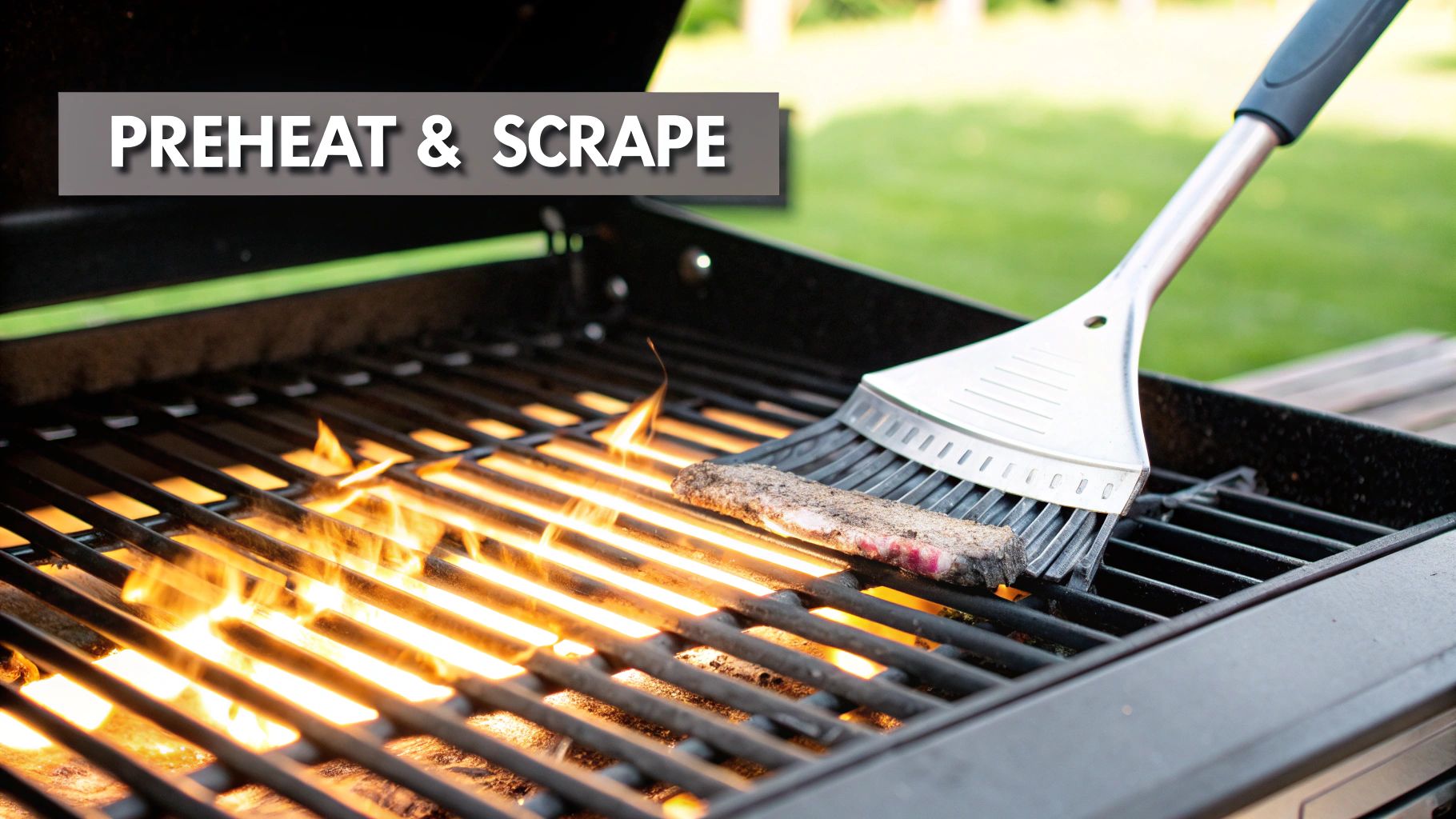
I've seen too many kitchens try to cut corners here, and it never ends well. Your non-negotiable basics are heat-resistant gloves, a proper heavy-duty scraper, and a commercial-grade, food-safe degreaser. The gloves are an absolute must for safety, especially if you’re cleaning a grill while it's still warm. A solid scraper, ideally one with a long handle, gives you the leverage to muscle off that stubborn carbon without getting your arms scorched.
Your choice of grill brush also matters more than you might realize. The market for these tools was valued at USD 150 million in 2024 and is on track to hit USD 250 million by 2033, mostly because of huge leaps in safety and design. We're seeing more bristle-free models that completely remove the terrifying risk of a wire bristle ending up in a customer's food.
Your Commercial Grill Cleaning Toolkit
Having a well-stocked kit means you’re ready for anything the grill throws at you. You can’t do a professional job with half the gear. I always recommend having a dedicated cleaning caddy or station so everything is in one place when you need it.
Here’s a quick checklist of what I consider essential for a thorough clean.
| Tool or Gear | Primary Use | Pro Tip |
|---|---|---|
| Heat-Resistant Gloves | Protects hands from hot surfaces and harsh chemicals. | Look for silicone or Kevlar gloves that extend past the wrist for extra protection. |
| Heavy-Duty Scraper | Removes thick, caked-on carbon and food debris. | A long-handled scraper provides better leverage and keeps you away from the heat. |
| Bristle-Free Grill Brush | Safely scrubs grates without the risk of leaving metal shards. | The coiled or woven designs are fantastic for getting into the grooves of the grates. |
| Food-Safe Degreaser | Breaks down stubborn grease and grime on all surfaces. | Always check that it’s approved for food-contact surfaces and follow dilution instructions. |
| Large Bucket or Tub | Soaking removable parts like grates and radiants. | A stainless steel or heavy-duty plastic bus tub works perfectly for this. |
| Scouring Pads | Cleans interior and exterior surfaces without scratching. | Use non-abrasive pads for stainless steel to avoid creating tiny scratches where bacteria can hide. |
| Microfiber Cloths | Wiping, drying, and polishing the grill's exterior. | Have separate cloths for cleaning and polishing to avoid spreading residual grease. |
This isn't just about having the tools; it's about making the job safer and more efficient. The right gear does most of the heavy lifting for you.
Remember, the goal here is to work smarter, not harder. Good tools protect your crew, your equipment, and ultimately, your food quality.
If you want a complete playbook that dives deeper into which tools to use and the exact techniques for cleaning every part of your unit, our full guide on commercial charbroiler cleaning is the perfect next step.
The Deep Cleaning Method That Actually Works
Forget all the half-baked advice that leaves you scrubbing for hours. A real deep clean on a commercial grill isn't about brute force; it's a systematic process. The secret is working with the grill, using residual heat and a smart sequence to break down that baked-on gunk without damaging your equipment.
The first scrape-down is your golden opportunity. While the grill is still warm (but definitely turned off!), grab a heavy-duty scraper and muscle off all the big stuff. That leftover heat keeps the grease soft, making it ten times easier to lift off the grates. I'm not kidding—this one step can literally cut your total cleaning time in half.
Get Those Grates Soaking
Once you’ve scraped away the surface-level grime, it's time to deal with the stubborn, cooked-on layers. Carefully pull off the cooking grates, along with any heat shields or flavorizer bars. Get them fully submerged in a large tub filled with hot water and a commercial-grade, food-safe degreaser.
Don't rush this part. Letting these components soak is what does the heavy lifting for you. The degreasing solution needs time to penetrate and dissolve the polymerized grease that scraping alone will never touch. While it's working its magic, you can get started on the rest of the grill.
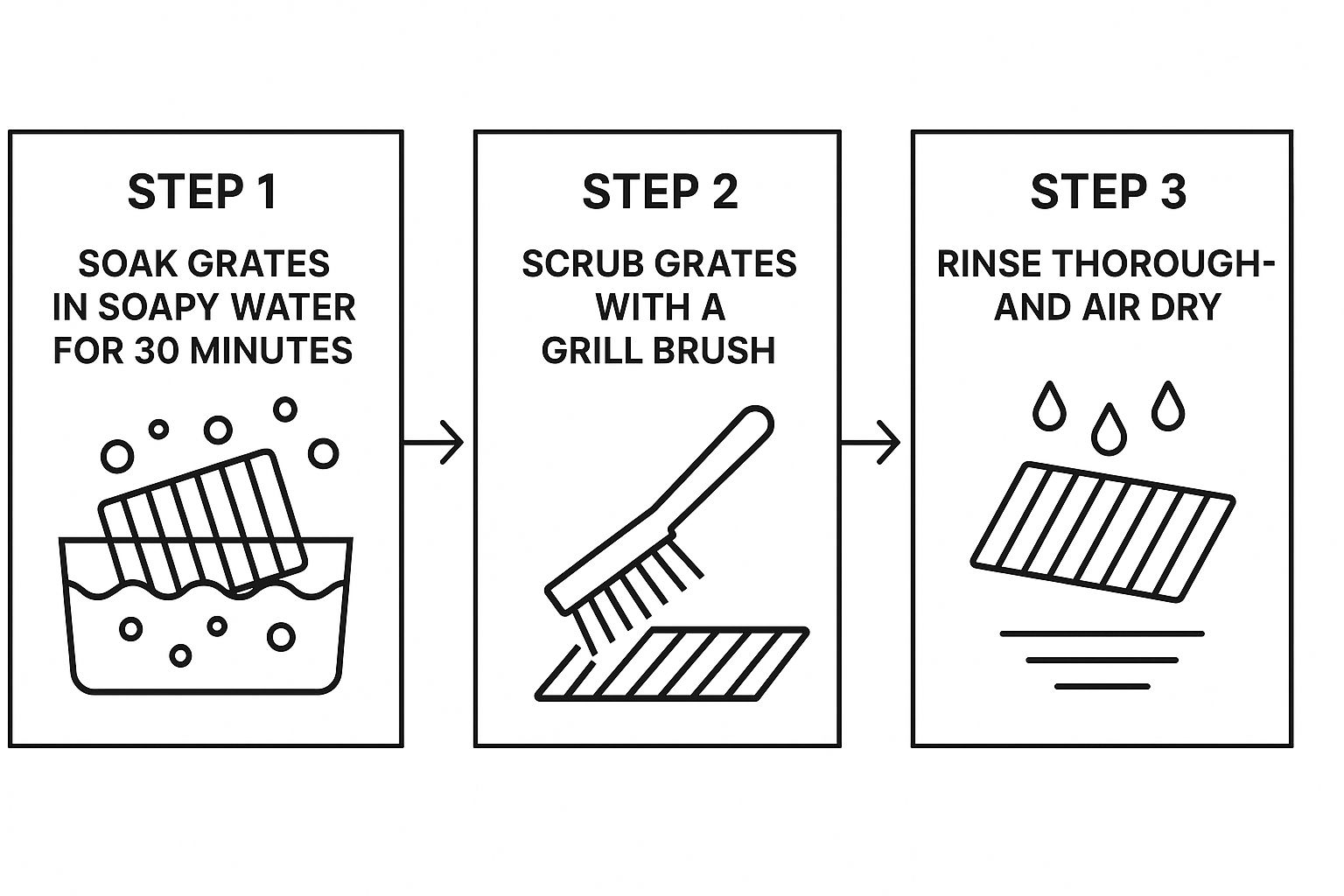
This simple soak, scrub, and rinse flow is your ticket to a perfectly clean surface. If you want to get into the nitty-gritty, especially for pricier equipment, check out our detailed guide on how to clean stainless steel barbecue grates for tips on protecting your investment.
Tackle the Grill Interior
With the grates soaking, pivot your attention to the grill's guts. The firebox, burners, and grease trap are where the most hazardous grease builds up, but they often get overlooked. Use your scraper again to knock down any large deposits from the interior walls and the bottom of the firebox.
Next, hit those interior surfaces with your degreaser and a non-abrasive scouring pad to scrub away what’s left. Pay extra attention to the burner tubes—you need to make sure none of the ports are clogged with debris. Blocked ports are a primary cause of uneven heating and cold spots.
A clean firebox and clear burners are every bit as important as clean grates. This isn't just about performance; it's one of the most effective ways to prevent a dangerous grease fire in a slammed kitchen.
After a solid scrub-down, rinse everything with clean water and dry all the components completely to stop rust in its tracks. Reassemble your grill, then do a final "burn-off" by running it on high for 10-15 minutes. This last step seasons the grates and gets your charbroiler perfectly prepped for service.
Adapting Your Cleaning to Different Grill Types
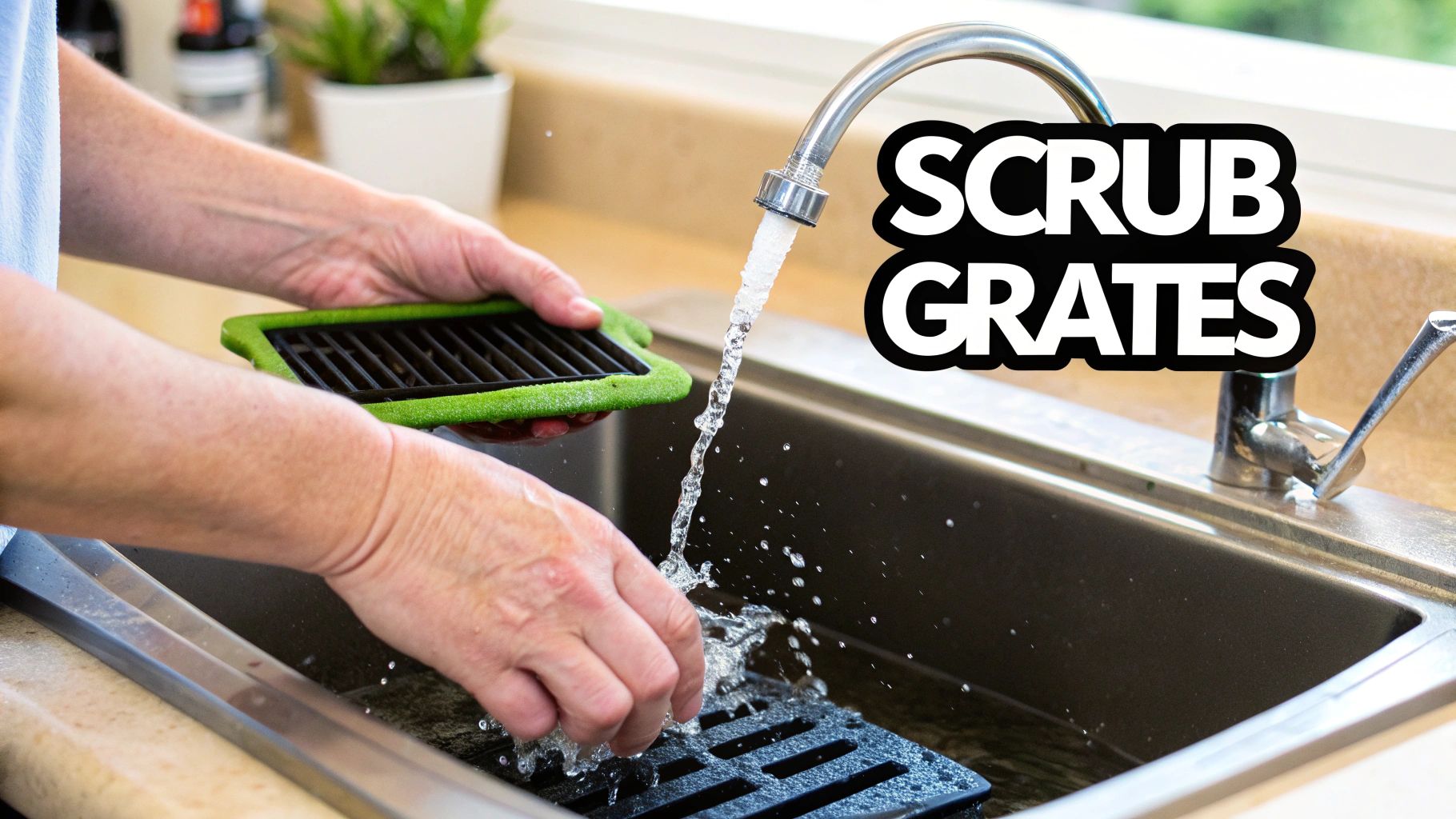
There’s no one-size-fits-all playbook when you’re figuring out how to clean a commercial grill. What works for a rugged gas charbroiler could spell disaster for a delicate infrared unit. Your cleaning strategy has to be smart, and that means adapting it to the specific type of equipment you’re running.
Each fuel source and heating technology comes with its own set of components that need specific care. Get it wrong, and you’re looking at damaged parts and subpar performance. Get it right, and your grill will run like a champ for years.
Cleaning Different Commercial Charbroilers
Gas charbroilers, for example, are the workhorses in most kitchens. The absolute key to keeping them happy is focusing on the burner tubes. It’s amazing how fast food debris and grease can clog those tiny gas ports, which leads to uneven flames, frustrating hot and cold spots on your grill surface, and even dangerous flare-ups.
Electric charbroilers, on the other hand, demand a different kind of respect. The name of the game is protecting the electrical components. You’ve got to get those heating elements and drip pans clean, but without using a ton of water or harsh chemicals that could cause a short. Keeping that baked-on gunk off the elements is non-negotiable for efficient cooking and preventing that nasty burnt flavor from ruining your food.
The biggest mistake I see crews make is going at every surface with the same aggressive scraping tools. This can be catastrophic for something like an infrared burner, which relies on a more fragile surface to generate that intense, searing heat.
A cleaning routine tailored to your specific grill doesn’t just protect your investment. It’s the secret to getting the absolute best performance, whether you're searing steaks on an infrared unit or slow-grilling vegetables on a gas model.
To make it simple, let's break down where to focus your attention for each of the main types of commercial charbroilers.
Cleaning Focus by Charbroiler Type
This table cuts right to the chase, highlighting the most critical cleaning area for each charbroiler type and the common mistake that can lead to costly repairs or poor performance.
| Charbroiler Type | Key Cleaning Area | Common Mistake to Avoid |
|---|---|---|
| Gas Charbroilers | Burner ports and heat radiants | Using wire brushes that damage ports or failing to clear blockages, causing uneven flames. |
| Electric Charbroilers | Heating elements and connections | Applying too much water or corrosive cleaners that can short-circuit electrical components. |
| Infrared Charbroilers | Ceramic or glass surfaces | Using abrasive scrapers or pads that can crack or scratch the delicate infrared emitters. |
Think of this as your cheat sheet for keeping each machine in peak condition. A few minutes of focused, correct cleaning saves hours of headaches and ensures every dish comes off the grill just right.
Make Smart Daily Maintenance a Habit
A weekend deep clean is great, but what you do between those big sessions is what really keeps your grill in fighting shape. Building a few smart, simple habits into your daily closing routine is the secret to making those deep cleans way less painful.
These little steps stop that nasty, baked-on crud from ever getting a foothold, saving you hours of future scrubbing.
The absolute cornerstone of daily care is the classic “burn and brush” technique. After the last ticket, crank the grill to high and let it roar for 10-15 minutes. This turns most of the fresh gunk into ash, which is a whole lot easier to deal with.
While the grates are still screaming hot, give them a quick but tough scrub with a good grill brush. This move alone prevents grime from setting up camp for the long haul.
Your Daily 3-Minute Check-Up
Beyond the brush-down, a few other tasks need to become muscle memory for your kitchen crew. They’re quick, but they make a massive difference in safety and the health of your equipment.
- Empty the Grease Trap. Every. Single. Day. This one’s not up for debate. An overflowing grease trap is the number one cause of dangerous flare-ups and kitchen fires. Get it clean.
- Season Your Cast Iron. If you’re rocking cast iron grates, wipe them down with a super-thin layer of high-smoke-point oil after you clean them. This creates a barrier against the air's moisture and stops rust from forming overnight.
- Spot Trouble Before It Starts. Just take 30 seconds to eyeball the key parts like burners and radiants. Are you seeing excessive rust? Any cracks? Clogged ports? Catching these things early means you can schedule a repair instead of dealing with a full-blown emergency mid-service.
It's also worth looking at new tools that can make the daily grind easier. For instance, steam clean grill brushes are becoming more popular in professional kitchens. They use the power of steam to slice through grease without harsh chemicals or the risk of leaving dangerous wire bristles behind.
You can learn more about how steam-based grill cleaning tools are changing the game in kitchen safety and efficiency.
Common Grill Cleaning Questions Answered
Even with the best cleaning routine, questions pop up. I've seen kitchen managers and new hires run into the same handful of snags when they're learning the ropes of proper grill maintenance. Let's tackle some of the most frequent issues I hear about.
How Often Should a Commercial Grill Be Deep Cleaned?
This is the big one, and the answer comes down to one thing: your kitchen's volume.
For a restaurant that’s constantly busy, a full, top-to-bottom deep clean is non-negotiable at least once a week. If you’re running a lower-volume operation, you might get by with a bi-weekly schedule, but that’s pushing it.
Daily habits, however, are set in stone. The end-of-service burn-and-brush, along with emptying that grease trap, has to happen every single day. No exceptions. It's the only way to prevent hazardous buildup and keep your food tasting clean.
The biggest cleaning mistakes? Using abrasive steel wool on stainless steel—it creates micro-scratches where bacteria love to hide. Another is pouring cold water on hot cast iron grates, which is a surefire way to crack them.
One more critical error I see is not rinsing chemical cleaners off completely. Any residue left behind is going to burn during the next service, filling your kitchen with acrid smoke and making everything taste... well, like chemicals.
Can I Use Oven Cleaner on My Charbroiler?
I get this question a lot, and my answer is almost always a hard no. Unless the product label specifically says it's safe for your charbroiler’s materials, don't do it.
Most standard oven cleaners are way too caustic. They can permanently damage grill components, from the finish on your grates to the internal wiring on an electric model. It's just not worth the risk. Always stick with a degreaser formulated specifically for commercial kitchen equipment to protect your investment.
How Do I Handle Persistent Rust?
Rust is the age-old enemy, especially when you're working with cast iron grates. The best defense is a good offense: keep them properly seasoned with a thin layer of high-smoke-point oil after every cleaning.
If you're already seeing rust spots, don't panic. You can absolutely get rid of them with a good scrub, but there's a right way to do it. For a full breakdown, check out our guide on how to remove rust from a grill without causing damage. Once it's gone, consistent seasoning is your best friend to keep it from coming back.
At Charbroilers, we know that having the right equipment is just as important as keeping it clean. We offer a wide selection of commercial charbroilers for your restaurant, including powerful infrared, reliable gas, and efficient electric char broilers. Explore our full range at https://charbroilers.com.
